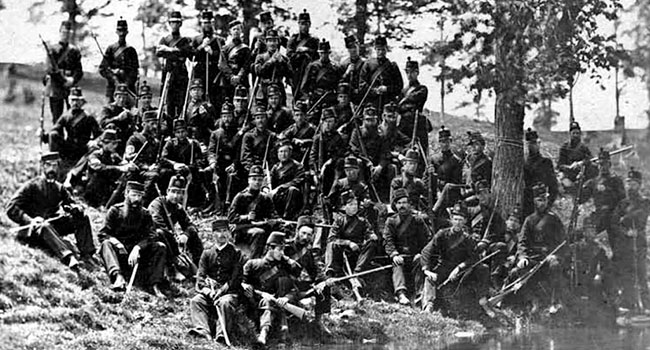 When I was a child in Dublin, a popular patriotic ballad began with the line “Deep in Canadian woods we’ve met, from one bright island flown.” No, it wasn’t about the joys of being a lumberjack – it was a celebration of the failed 1866 Fenian invasion of Canada. The Fenians, you see, were folk heroes in my childhood world.
When I was a child in Dublin, a popular patriotic ballad began with the line “Deep in Canadian woods we’ve met, from one bright island flown.” No, it wasn’t about the joys of being a lumberjack – it was a celebration of the failed 1866 Fenian invasion of Canada. The Fenians, you see, were folk heroes in my childhood world.
Established as the American branch of the Irish Republican Brotherhood, the Fenians had big ideas after the conclusion of the U.S. Civil War. The plan was simple. They’d use the thousands of Irish-American ex-Union army soldiers to strike at Britain and win Ireland’s independence.
But landing a Fenian army in Ireland would be very tricky. It would require – among other things – bypassing the powerful British navy. So using the United States as a base for invading the British colonies in Canada struck them as a feasible alternative.
For one thing, seriously disrupting the colonies might impel the British to do a deal on Ireland. And there was even the prospect of triggering a war between Britain and America, which would compromise Britain’s ability to suppress a planned Fenian uprising in Ireland itself.
| RELATED CONTENT |
| Fenians used Canada as an Irish revolutionary pawn By Pat Murphy |
The critical year was 1866, and the kickoff was a planned April attack on the Atlantic colony of New Brunswick.
Gathering several hundred men in Eastport, Maine, the Fenians set out to seize Campobello Island as a base for attacking British ships. But the whole thing fizzled, thanks to the arrival of a British naval squadron and the confiscation of a Fenian arms shipment by the Americans.
The second strike, though, had somewhat better luck – at least initially.
On the night of May 31, 1866, about a thousand Fenians under the command of Col. John O’Neill landed in the Niagara Peninsula and occupied the village of Fort Erie. Then on June 2, O’Neill’s brigade defeated a volunteer militia at the Battle of Ridgeway, killing nine Canadians, including three University of Toronto students who had been sitting their final exams when they were called into action.
That, however, was the invasion’s high water mark. With an American gunboat patrolling the Niagara River to prevent Fenian reinforcements and a substantial force of British and Canadian soldiers en route, O’Neill withdrew back across the border.
The third and final strike of 1866 was doomed from the beginning. Fenians gathering in upstate New York and Vermont found themselves harassed by American authorities who impounded their arms and ammunition.
So, in an act of desperation, around a thousand crossed the border into Quebec on June 7 and briefly occupied several villages. But faced with a numerically superior British and Canadian force, the invasion collapsed.
From the comfortable vantage point of the 21st century, it’s very tempting to view the whole Fenian enterprise as an exercise in fantasy. But was it really?
Certainly the idea of triggering a war between Britain and America was farfetched. Tolerating the Fenians to annoy the British was one thing, but Washington had no interest in letting events get out of control. In that sense, you could say that the Americans used the Fenians rather than vice versa.
As for the invasions themselves, without local uprisings to support them, the attackers simply didn’t have the numbers to make it work. But while those uprisings didn’t happen, there’s still the question of whether they could have.
Historian David Wilson believes that a significant minority of Irish-Canadian Catholics were sympathetic towards the Fenians. While actual Fenian membership in Canada may have been no more than 3,500 (out of an Irish-Canadian Catholic population of around 260,000), he reckons that the number of fellow travellers extended substantially beyond that.
Still, even if uprisings had occurred, it’s hard to see the Fenians being ultimately successful. The combination of the overwhelming Loyalist majority, the Orange Order and the British army would have seen to that. And in the ensuing mayhem, the integration and acceptance of Irish Catholics would have been set back disastrously, perhaps irrevocably.
So the rebel song The Bold Fenian Men may have sounded heroic in the Dublin of my childhood, but the view from Toronto a century and a half on is very different.
Troy Media columnist Pat Murphy casts a history buff’s eye at the goings-on in our world. Never cynical – well perhaps a little bit.
The views, opinions and positions expressed by columnists and contributors are the author’s alone. They do not inherently or expressly reflect the views, opinions and/or positions of our publication.


